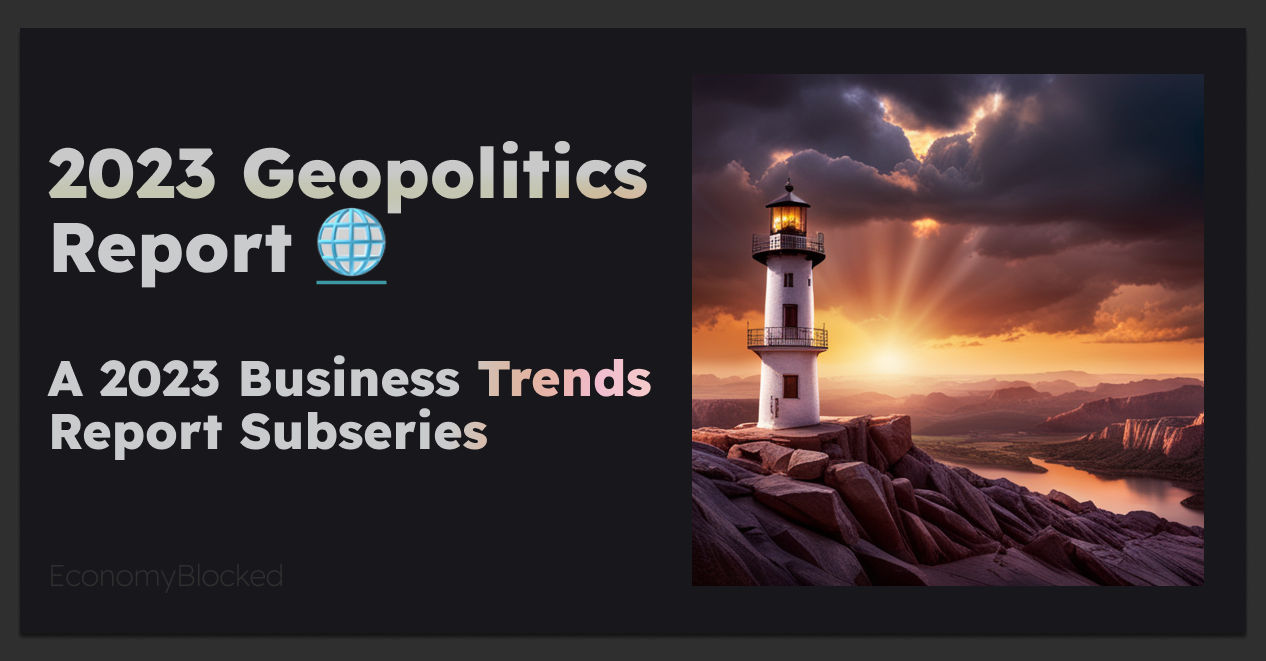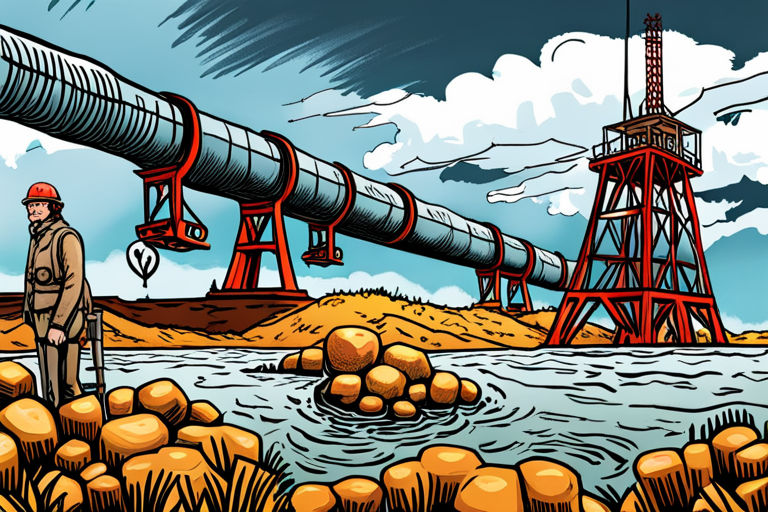🌏 Introduction
The following is part 1 of a 2-part series on geopolitics and macroeconomics as part of my 2023 business trends report series – To kick things off we will review 2023 geopolitical regional trends that can be viewed as some of the most pressing geopolitical events of our time, including the US-China trade war, the Iranian uprising, territorial disputes, and the war in Ukraine. From there, we will review Europe’s energy dependence, crypto regulation, deglobalization, and concluding with food insecurity.
So let’s get started!

🧩 Table Of Contents
🇻🇮 🇨🇳 US-China Trade War: Geopolitics, instability, and Global Employee Sentiment
The US-China trade war will still have a significant impact on global politics in 2023. Former President Trump implemented the first measures, and the current administration has continued them. In retaliation, China imposed retaliatory tariffs on US goods imported into the country and devalued its currency, the Renminbi(Yuan). Many countries are scrambling to implement their own policies in order to avoid collateral damage.
🌋 Instability ahead
The Chinese Communist Party’s zero-covid policy measures have prompted millions to take to the streets in protest. As most of the world is in a period of convalescence from the pandemic, the Chinese people are fed up with the oppressive policies forcing them to remain indoors, test, and quarantine, by the will of an authoritative government.
It is the single largest political act of disobedience since 1989’s Tiananmen Square incident. Due to the demonstrations, quarantine and zero-covid restrictions have been loosened, which is one of the first examples of the Chinese Communist Party relinquishing power as a result of public pressure.
🚧 Workforce sentiment shifts
As a result of COVID-19, worker sentiment also suffered in China. The Let It Rot, Bai Lan, and Lay Flat movements argue that pursuing a career or education requires unrealistic and unattainable expectations, and the average Chinese worker, mainly of the younger demographics, questions everything. Due to societal pressure and lack of prospects for personal gain, people have lost hope, which may indicate that communism poses a particular economic danger and that any authoritative power will eventually fall.
What is the point of striving for personal gain when you know you will never succeed? As a result of the COVID-19 pandemic, workers in developed and developing countries have become less productive and more combative, with the trend likely to continue in 2023. In the United States, similar worker sentiment has been brewing since the beginning of the pandemic, with the Quiet Quitting movement, among knowledge workers and young professionals, sharing a similar belief to the sentiment held in China.
愛 China’s Geopolitics
China’s foreign policy in 2023 will most likely continue along similar lines as in 2022, with focused attention on reopening the economy by allowing foreign investments and tourism, and will most likely continue to push continued military development and growth to counter US military power in the region.
As both the US and China position their military as a show of force in the region, the dispute over Taiwan, a free and democratic sovereign nation, is likely to persist in 2023. In the wake of Russia’s invasion of Ukraine, the CCP may decide not to take action and invade Taiwan, a country they believe is rightfully theirs.

🇮🇷 Iranian Uprising and Iranian Geopolitics
🧕🏼 The political killing of Mahsa Amini
In Iran, protests erupted following the death of Mahsa Amini on September 16, 2022, a 22-year-old woman who was arrested for not wearing a hijab. Demonstrators called for the end of the Islamic-state Republic after the protests turned into a wider movement against the government. Despite a heavy crackdown by Iranian security forces, including the arrest of hundreds of demonstrators, the protests have continued.
☢️ Regional Instability ahead
Despite not knowing how this event will affect the political climate in 2023, it is likely that the demonstrations will continue because Iranians share a common belief, in life and in women’s freedom.
Based on the ongoing protests throughout Iran, under a regime that has already executed protestors for crimes against the state, many journalists and political scientists are speculating that we are currently seeing the downfall of the current regime in Iran, and will most likely collapse within generations based on recent reports by the BBC.
“The politics of Iran takes place in the framework of an Islamic theocracy which was formed following the overthrow of Iran’s millennia-long monarchy by the 1979 Iranian Islamic Revolution.” For businesses operating within the greater middle-east region, tracking this conflict and the ongoing tensions may be in the best interest of international organizations, non-profits, or any other organization operating within the region.

🇺🇦 🇷🇺 Ukraine: A Geopolitical and Economic Analysis Of The Conflict With Russia
⚔️ War Optics
The Russian and Ukrainian conflict originally began in 2014 when Russia annexed Crimea. During this time, Russia supplied arms and resources to pro-Russian separatists in Ukraine’s east and south, which was contested by the US and EU-equipped Ukraine, and support, by way of armaments, training, and resources has been slowly making thier way into Ukraine until the breakout of the most recent conflict in 2022. Russia is effectively attempting to take control over sovereign territory, making this Russia’s greatest exercise of force in the eastern block since the fall of the Soviet Union in 1989.
⚠️ Analyzing the ways in which the war may end
This war can end in a few potential outcomes, ideally starting with a cease-fire, however, the fighting persists, and it appears Russia has been arming its heavy bombers to potentially execute more attacks on energy infrastructure and other critical infrastructure in the coming weeks and months - It is clear that there are two motivating factors behind this war: ideology and Putin’s desire to unite the eastern block that was lost after the collapse of the Soviet Union.
⚡ Unpacking the war and dispelling ideological assumptions
Western ideological expansion by NATO in Ukraine was viewed as an act of war. As the Western style of democracy stands in direct contrast to the Kleptocractacy and autocracy of the Russian Republic and its political philosophy. But wait, is Ukraine a democracy? The answer is no, in my opinion, which warrants a further review of this subject.
Several opposition leaders were imprisoned in Ukraine, communist regimes were forcibly destroyed, and power was controlled by a select group of elites. So is this war truly about East vs West, democracy vs autocracy? – I personally believe this is purely a proxy war over economics, not necessarily between the authoritarian East and the democratic West. With that notion dispelled, how can we better understand, therefore operate in a world in which proxy wars will most likely continue as power struggles continue and Putin continues to fight his zero-sum game, war? A war by which he can not lose, for if he does, both he and his entire system of oppression will implode.
That is the question I suggest as a preposition, something to consider depending on your company’s exposure to Ukraine and Russia. The Ukraine and Russian regions have become major resources for cheap software engineering labor over the last decade, with many outsourced development companies locating their entire development team in either region. It may be worth considering adopting a near-shore team approach in countries like Peru or Argentina if your business model relies on cheap, high-quality engineering talent.
☭ Unpacking Putin’s approval ratings
81% of the Russian population is pro-Putin, which is a mind-boggling stat considering the number of Russians that fled the country. But all but most political threats to Putin’s regime have been either greatly reduced or rendered non-threatening. But when viewing under the hood of the Russian economy, it’s clear there are issues his approval ratings simply do not expose, which I assume will elucidate in due time.
Let’s unpack his approval rating a bit more: Ultimately, if the remaining 19% are Putin’s detractors who represent the ruling or business class, then his continued control over the country will be fleeting at best. But if we consider the possibility of the Russian State imploding, we find ourselves contending with another greatly challenging geopolitical situation for the world.
🅾 The zero-sum game
For example, in the event of the Russian state imploding, a country that relies on a significant nuclear stockpile to exercise thier political might, the world would be effectively trading one contentious situation with another potentially more troubling situation if that stockpile fell into the wrong hands, or a poorly managed government or a government vying for power. So here we are…

🇪🇺 ⚡️ Europe’s Energy Dependence
🛢️ What is the Nord Stream Pipeline?
Nord Stream pipelines were the main pipelines that transported hydrocarbons from Russia to Europe - Nord Stream 1 carries natural gas from Russia to Germany through the Baltic Sea. It was constructed in 2011 and consists of two parallel pipelines, each with a capacity of 27.5 billion cubic meters of natural gas per year.
The Nord Stream pipeline is a major gas pipeline that runs through Finland, Denmark, and Germany, connecting Russia to Europe. It was first proposed in 1997 and completed in 2012. The pipeline has been a major source of contention between Russia and Europe, as the pipeline allows Russia to bypass Ukraine as a transit country and avoid paying transit fees. This has resulted in a number of sanctions and disputes between the two countries.
🌎 The geopolitics of the Nord Stream Pipeline
Additionally, many European countries have expressed concern that the pipeline is a form of political leverage for Russia and could be used to increase their influence in Europe. The Nord Stream pipeline has been a major factor in the recent geopolitical environment in Europe, and will likely remain so for the foreseeable future.
The Nord Stream 2 pipeline system is an extension of the Nord Stream 1 pipeline system. The project was proposed in 2015 and aimed to double the existing pipeline’s capacity to 55 billion cubic meters of natural gas per year. Initially, the pipeline would have been completed in 2020, but Germany ended the project two days before the Russians evaded Ukraine. In September 2022, the pipelines were attacked by an unknown attacker.
In mid-December I published the first post from my 2023 Business Trends series, which this post technically falls under, I called out that we were experiencing a colder-than-usual winter, but that has dramatically changed within the last 5 weeks. It has officially been one of the warmest winters on record. This has decreased energy consumption substantially this winter throughout Europe and has given Russia less leverage over the ongoing conflict.
⛽ US LNG Exports
As of Q1 2023, the US is now the second leading exporter of LNG in the world, behind Qatar. The US currently exports around 1.4 million cubic feet of LNG per day but is expected to increase to 2.3 million cubic feet per day by 2025. This is a drastic increase in the US exports of LNG. This trend will help offset the lack of Russian-suppled gas in Europe, which is likely to persist for the duration of the ongoing conflict, and well beyond.
For more information about the Energy Sector, checkout part 1 of the business trends report, 2023 Energy Sector Forecast, covering everything from market research, to the key technology innovations that will have the greatest level of impact in 2023.

💱 Crypto Regulation
🩸 There’s blood in the water
Within the decentralized ledger space: Crypto and blockchain industries, the market has been experiencing a persistent period of bankruptcies beginning with the Terra-Luna debacle, and the lack of regulation around algorithmic stablecoins. More recently and with the very public downfall of FTX, policymakers and regulators are scrambling to pass legislation to regulate the blockchain and crypto industries to protect customers from highly volatile, speculative assets.
⚖️ Unpacking crypto regulation
Cryptocurrency regulation is the rules, guidelines, and legislation governing how cryptocurrency is created, bought, sold, and used. It began in the early 2010s when governments around the world began to recognize cryptocurrency’s potential as a new asset class. As a result, governments introduced laws and regulations to protect investors, promote innovation, and curb illicit activities such as money laundering and tax evasion. However, it is still a highly unregulated industry, so investing in any centralized entity or blockchain project is a literal gamble.
In 2023, cryptocurrency regulation will be influenced by a number of geopolitical and macroeconomic factors. We can almost guarantee that all governments will set much stricter guidelines and regulations in the coming year. Most countries have adopted a wait-and-see approach, in vain, and now to the detriment of their citizens. In the crypto and blockchain industries, $2 trillion USD of total market value has evaporated since March 2022, as a result of devaluation, capitulation, and bankruptcy, and over $110 Billion USD of personal wealth has also been zeroed out, based on a recent report by Forbes. When nations began exploring the crypto space, they allowed experimentation but reserved the right to introduce stricter regulations if necessary.
It is clear that digital assets are here to stay, with more and more institutional investors positioning their portfolios with the necessary infrastructure to support blockchain-based assets(DLT). This trend will likely track the overall progress of regulation more broadly in 2023.

🗺️ 🔫 Deglobalization
Deglobalization refers to the reversal of globalization and the return to an international system characterized by greater economic, political, and cultural separation. There have been a number of factors contributing to this process, including the rise of protectionist policies, the resurgence of nationalist and populist movements, the pressure to address climate change at home, the backlash against free trade agreements, and the threat of pandemics.
As countries become more focused on protecting their own borders and forming regional alliances, deglobalization is likely to affect regionalization or reflect globalization 2.0. There could be a decrease in international investments and trade, an increase in tariffs, and a corresponding increase in domestic production and consumption as a result.
❌ As the world moves from multi-polar to Uni-polar
One callout about deglobalization: We live in a world that has never been presumably smaller or more connected as a result of the internet, yet divisiveness and derisiveness are increasing substantially over time. We live in a world that has never been more homogenized, yet so disjointed. Therefore, the internet and technology are to blame. This logic is a bit too binary, but it does a sufficient job of encapsulating my position.
🌐 Outcome of deglobalization on the macro environment
In terms of macro, deglobalization is likely to lead to slower economic growth as countries withdraw from global markets. Additionally, some loss to economies of scale and the increased cost of production could increase prices and lower wages. Deglobalization will likely result in a global economic contraction of ~ 4% in 2023. Global trade could also decline by ~ 5-10%, which could have a significant impact on global GDP growth according to the International Monetary Fund. Macro will be unpacked in more detail in part 2 of this subseries as will deglobalization in parallel.

🌾 Food Insecurity
One of the most pressing geopolitical issues of the 21st century is food insecurity and scarcity. In 2020, the COVID-19 pandemic exacerbated this issue, disrupting food supply chains and leaving millions of people without adequate access to food.
Over the next few years, this trend is expected to continue to play a major role in global politics. Aside from the pandemic, other factors contributing to food scarcity include population growth and collapse, climate change, and land and water shortages. The geopolitical implications of food scarcity will continue to increase as global leaders attempt to address these issues, introducing policies and laws that will ideally help to counteract this trend.
🚜 Russia and Ukraine: The breadbasket for much of the developing world
In terms of grain and wheat exports, Russia and Ukraine are the breadbaskets for much of the developing world. And with the conflict ongoing, the world should factor in this deficiency, as the end game for Putin is zero-sum, and will presumably drag on for quite some time.
⚒ Unpacking Food Insecurity Statistics:
Throughout 2022, Food insecurity was a major issue across the world. Approximately ~ 690 million people, or ~ 8.9% of the world’s population, suffer from hunger, according to the UN World Food Program. Additionally, due to the ongoing global economic crisis brought on by COVID-19, 135 million people are estimated to be living in extreme poverty, putting 2 billion people at risk of hunger.
Up to 500 million people may be affected by food insecurity due to the effects of climate change, according to the World Food Program. Global food systems have been significantly affected by the pandemic, with an estimated 1.3 billion people facing food insecurity. A projected 1.4 billion people will suffer from extreme poverty and food insecurity by 2023.
❎ Viewing Food insecurity as an opportunity
Ultimately, the free market will provide the best solution to this problem, so it is vital to get involved and start thinking about it as a business case that must be validated and solved in order to ensure a better future for all.

🌐 🏅 Closing Thoughts
2023 will go down as a year of inflection for many of our systems and institutions, from politics to society to business and family systems, and across all regions, as the world reaches a point of inflection and tension. Deglobalization, climate change, food insecurity, staffing issues, the war in Ukraine, China, and US tensions, and the list goes on – Though each of these events seems austere, each can be viewed as an opportunity to solve a problem and create new businesses to solve said problems, thereby allowing us to view each of these events as opportunities.
Please check out part-2 of the geopolitics and macroeconomics sub-series, which focuses on macroeconomics, and continues the geopolitics conversation focused on APAC and India more specifically, and moret…
👾 More Recent-Posts
-
Bitcoin (BTC) Revolution: Catalyst, History, and Analysis
The main goal of this piece is to gain a deeper understanding of the reasoning behind the creation of Bitcoin, allowing for a more comprehensive perspective on its future
-
Macro & Geopolotics Report: 2023 Business Trends Report
In this post, we discuss macroeconomics, as well as geopolitics as part of the 2023 Business Trends Report 🌍
-
💲NEAR Protocol: Overview and Price Prediction
In this article, we will be conducting an extensive analysis of the 💲NEAR protocol, which is the platform I have the most experience building dApps on, as a Product Manager in web3
-
8 Healthcare Industry Trends and Innovations
In this post, we will be reviewing 8 business trends for the healthcare industry, including each of it's sub-industries, such as MedTech🔬
-
Cardano(ADA) Overview and Price Prediction
As a part of this post, we'll be reviewing what Cardano (ADA) is, its benefits, Tokenomics, a price prediction model, and the future of its fledgling ecosystem 💱
-
Ruby on Rails and The Future Of MVC
Discover the amazing potential of Ruby on Rails! Learn about its history and design philosophy, why it's the perfect choice for web development, and how to get started with the framework ♦️
-
Artificial Intelligence: Business Trends Report
Large language and generative models are reaching a point of emotional realness that they can no longer be distinguished from humans 🚀
-
Post-Industrial Digital Banking
Explore the post-industrial era of digital banking. Deployment-based market research, post-industrial hypothesis validation,opportunities,and more 📲
-
How 👾 (AI) Will Transform Product Management
In this post, we will unpack how (AI) will transform aspects of product management, as well as it's impact across cross-functinoal teams 🎖️
-
2023 Transportation Industry Trends 🚊
In this post, we will be covering 2023 Transportation Industry Trends, including market research, business strategy, and more... 🚉
-
Energy Sector Forecast 2023 ⚡
The 2023 Business Trends Report covers sector-based projections, major innovations, market dynamics, opportunities, and technologies by sector or industry - this post covers both traditional and renewable energy markets 📈
-
To-Blog Or Not-To Blog❓ | 2023 Blog Launch Helper |
This post is designed to help you or your team launch and optimize a successful blog by examining why businesses blog, providing a blog business plan guide, exploring SEO and analytics tools, and an overview of blogging platforms and frameworks
-
Make the web fast again | What is a CDN❓| How do CDNs work❓
In this post, we review what a CDN is, how they work, the business of cdns, as well as some of the best options to consider when choosing a cdn
-
We're In Way Over Our Heads | Going Headless (CMS)
Content is king! In this post we review Headless-CMS, content management systems; How they work, an overview of JAMstack, some of the best options, etc, will be discuessed
-
Building Static Websites In An Un-Static-World (SSGs)
In this post we'll be reviewing (SSGs) static site generators, reviewing the tech as a means of providing value to your next project or business during times of uncertainty– The advantages, how they work, and evaluating frameworks, including Jekyll, Hugo, and Gatsby. JS, etc 🛠
-
How (AI) is changing the way we work
In this post, we'll explore two use cases for (AI) ⚔️ (AI) Writing and Text-To-Image (Generative-AI) – How they work, as well as their current and future, use cases for the workplace, as well as available tools and services
-
Industrial Revolutions
Part-1 (1-2 IR) This is the first post of the Industrial Revolution series, covering the 1st and 2nd Industrial Revolutions, major tech innovations and advancements during each period
-
Industrial Revolutions
Part-2 (3-4 IR) This is the second and final post of the Industrial Revolutions series, covering the 3rd and 4th Industrial Revolutions. Focusing on the tech and innovations during this period
-
Tokenomics
Ledgers and Accounting represent two foundational aspects of tokenomics and token-engineering, this is the first of many post where I will be covering tokenomics, focusing on presenting my research and aspects of system design
-
Fintech Deep-dive
How the tech industry is changing finance: This post outlines the history of financial technology (FinTech) and major innovations, as well as companies at the forefront of this sector
-
Web 3 Systemic Issues Report
In this post I review some of the most systemic-issues that I have identifed after contributing to a few web3 startups in varying levels of involvement – please take what is stated as speculative conjecture, nothing more 🙏